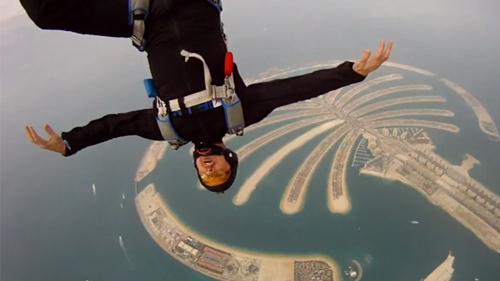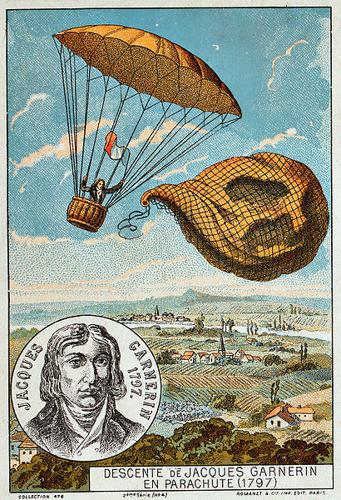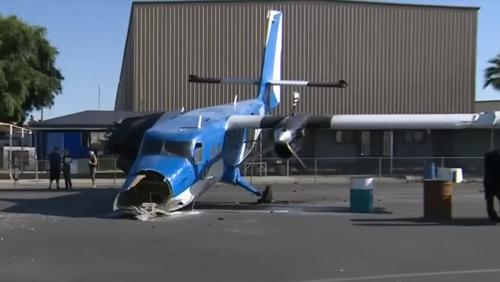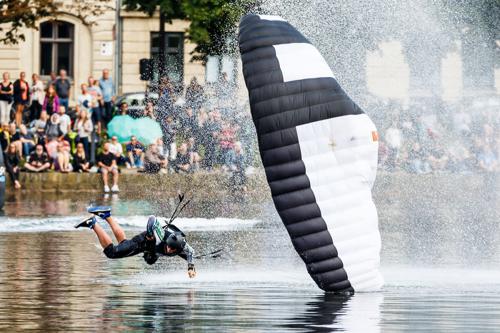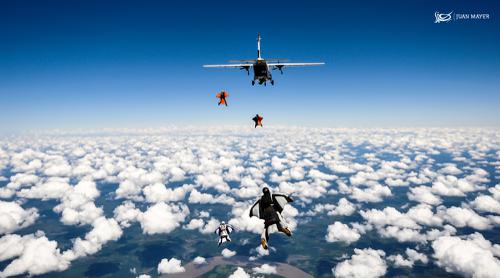Numerous people have asked me how to start and maintain a club in the past, so I have put together a little (or not so little) essay on how to do this. I started the skydiving club at the University of Maryland, College Park in September 1998. It has grown quite a bit since then and there is much more active participation by the members. The beginning of a club is very strenuous on the founder, as there is a lot of legwork and red tape to get through. But, someone has got to do it.
Each school works differently for how a club could be formed. Anyway, you could find our constitution at: http://www.inform.umd.edu/StudentOrg/cpsc/Documents/Constitution.doc I thought that you could use that as a standard constitution to see what you could put into your constitution. Each school has different rules on what should be in a constitution but for the most part, they are all the same.
You should see if you your school would actually permit such a club (skydiving) on campus. I say this b/c I have a friend who tried to start a club at U. Delaware and they didn't let him b/c the school takes on a different role with the student clubs there. At U. Delaware, the university has control over the club that they would be liable for any incidents. At U. Maryland, we are considered a student organization/club, NOT a sport club and the university allows us to do pretty much anything b/c they don't have any liability over us. The only thing that we must abide by are the basic university rules (non-discrimination, etc.).
Okay, so I could only tell you how I started the club here at U. Maryland as I don't know how it works at other universities. We needed to fill out a student organization form that required a President's and Treasurer's signature. Moreover, it required a minimum of 7 other undergraduate students to sign and put their social security #'s (Student ID's) on it. Finally, we had to have an advisor sign it. The advisor could be anyone who is faculty/staff of the university as long as they are not an undergraduate student (I'm UMD's advisor now as I finally became a graduate student and TA for the university). Most professors are kind of wary about signing a form to be an advisor for a skydiving club. Therefore, you might need to go to your Office of Campus Programs (that is what it is called at UMD) and request some literature to show to the potential advisor on what they are liable for or what they are not liable for within the club.
After you get them to sign the application and you have the signatures/SID #'s of other students and the constitution done, you hand it in to the Office of Campus Programs. It may take a little while for them to approve it as they need to read your entire constitution and pick out the details that need to be changed.
After they approve it, you might want to apply to the Student Government Association (SGA) to be a club under them. They may require you to change the constitution a little according to their policies but this is usually a standard procedure and the Office of Campus Programs should be aware of it already. So, you end up filling out another application to the SGA with some student signatures and Student ID #'s (25 minimum in UMD's case). After the SGA approves it, you may have to just be a SGA club without funding from the SGA for the first year. Again, it depends on the school. Anyway, the treasurer or whoever you have as the contact person would get a notification that a budget is due if you are requesting funding from the SGA. You need to fill out a budget with items that you wish the SGA would fund you for. I find the best way to get the SGA to fund a skydiving club is to orient everything around SAFETY as you stress that you want to keep all the skydivers in the club safe. They rarely refuse this. But, if you choose to itemize the same exact item without using the terms safety, they may reject your request. For instance, if you want to get some funding for equipment, you could call it "Safety equipment", which you may have to put under "Contractual Services" (as that is what it would be considered at UMD.
Another example would be time in the wind tunnel, which you could call "Free fall Safety Training". This would also fall under "contractual Services". At UMD, they have a few different categories that you could itemize things under such as "Transportation", "Advertising", "Contractual Services", "Subscriptions", and "Dues and Fees". "Transportation" would be the use of a motor pool that your school may have (i.e. van). "Advertising" would be something such as an ad in the school newspaper. "contractual services" typically means paying for a "lecturer" to come (in skydiving, it would be an instructor or some other skydiving expert). Or you could use "Contractual Services" for stuff such as Safety Training (as in my example of the wind tunnel). Moreover, you could designate the "Contractual Services" to alleviate the initial cost of 1st timers. The SGA would also be happy with this as you tell them the entire goal of the club is to get more students into the sport of skydiving and introduce diversity among the club while keeping it as cheap as possible. "Subscriptions" would be something like a subscription to "Skydiving Magazine" in the name of the club. But, this would be rejected if you don't have a centrally located office where students could come to. "Dues and Fees" would refer to the club membership fees to USPA ($200 the first year and $100 every year thereafter). The money from the SGA doesn't usually go directly to the club, but rather an invoice may need to be required by the company, which you want the SGA to pay with the Federal Employee # and mailing address for the check. The university may take a while to process this and send it to the company that you want the money to go towards. Our university is big on "Safety" and "Diversity". So, you could tell the SGA that you are trying to make the club as diverse and safe as possible, so you need their financial assistance. If the SGA says no, they are just pricks.
You could make your club a "sport club" by contacting your school's "Campus Recreation Services" department and talk to them about it. They may fund you after a year of recognition or so. This funding may include club gear (rig, etc.) and owned/maintenance by the Campus Rec. Services. But, at UMD, it ends up being a huge hassle b/c the Campus Rec. Services requires meetings every week, a lot of paperwork, permission for the club to leave the state (our dropzone is in a different state), and permission to spend money where we want to. The only advantage of becoming a sport club is that the Campus Rec. Services may potentially buy us gear. Of course, this all depends on the school.
Next thing you might want to consider (depending on the drop zone's waiver and the university's policies) is a legal waiver for your members to sign. You could get this done through the Student Legal Aid Office that some schools may have on campus. We started using the legal waiver when we first started but that got phased out b/c the drop zone's waiver covered us, as well as our club is just considered a "referrer" as opposed to a profit organization.
A website helps the club enormously in getting information out to the public and to the students who don't quite understand what skydiving is about. You should have descriptions of the types of jumps (i.e. Tandem, AFF 1, and Static Line), prices of the jumps, and pictures of what each type of jump looks like. Also, you should have directions to the drop zone, contact information for possible students, events calendar, FAQ section, statistics on how skydiving is safer than driving your car or even walking on a treadmill. You could take a look at our club's website to get a general idea of what information you may want to have on your web page at: http://www.umd.edu/StudentOrg/cpsc
You need to choose which drop zone will handle your club. You should call all of the local drop zones nearby and tell them that you are apart of a club at a university and you want to set some prices that are discounted dramatically from the regular price. If you are apart of a big university, you could tell them that and that you are potentially able to get hundreds of 1st timers each year. Also, you may want to work a club membership fee into the price of the 1st jump. That way, the club could make some money towards other things (i.e. boogies, gear, etc.). You could even have a "referral fee" worked into the price but that is your choice. Basically, you should have the total price be lower than the regular price by a good amount, which will increase your potential of getting students to jump through your club. Another thing to consider when choosing the drop zone is the type of aircraft they have. Drop zones with little Cessna's may not be able provide the necessary service for large groups. Also, if you were to charge a membership fee to people who are jumping through your club for the first time, you may want to give them something back in return such as a "free" t-shirt, sticker, etc. that would cost the club $5 per person. This money would be met up with the money from the membership fee. Anyway, this item that you would give the student would also allow you to get advertising on campus. A t-shirt would be worn around and others may ask that person about it. Then, they would probably direct those people to your club.
You should choose 2 - 4 jump dates throughout each semester to start off with. That way, if someone can't make it 1 of the dates, they could make it to another one. Before each jump date, you may want to have an "information session" meeting somewhere on campus. In the meeting, you should go over what each type of jump is like, the costs, the places to sleep/shower at the drop zone, safety, clothing to wear on the jump, what skydiving feels like (not roller coaster type of feeling), pics/video of people who already jumped who are in your club, etc. The pics/video of professional skydivers are good to get the students interested but it is also good to have some of the experienced skydivers at the university. That way, the students would realize that it is very possible that they could become good at the sport while having a good time as you started out the same way at some point. You may want to have the club pay for some pizza, which sometimes is an initiative to get people to go to the meetings. It is okay b/c it will pay off as people will become interested in skydiving through the meetings. You could make this meeting as formal or informal as you wish. You might want to have some gear there to explain the different components of it along with its safety devices (i.e. AAD and RSL). Moreover, you might want an instructor from the drop zone come and make a speech about skydiving and the drop zone itself. Just remember this, the students are going to be very nervous and scared about their first jump, so keep that in mind when giving a speech in these meetings. Don't make any skydiving jokes mocking death. In fact, explain to them that skydiving is safer than most acts of daily living. But, still keep their attention by telling them that you are a student too and like to have fun. Just don't act cocky about it as the students will think that their safety would be in jeopardy. The most important key to these meetings is to smile and act extremely excited about the sport. The students will draw off of your enthusiasm and you will have more students wanting to jump despite the costs!
Besides these information meetings, you should have general club meetings with the active members. You should discuss advertising issues, budget issues, etc. with them. This way, you all could brainstorm for more ideas as well as it would get the other members more involved with the club. This way, you don't have to do all the work. You could delegate the work so it is easy for everyone including yourself.
Advertising: You should plaster the campus with fliers in the most NOTICEABLE areas. For example, at UMD, no one put fliers up on the bathroom doors in the dorms nor in the elevators until after I started doing it. Students notice these fliers while ignore the most used flier spaces (i.e. kiosks). You may want to make quarter sheet fliers and pass them out at a place on campus that many students frequent (i.e. Student Union or Dining Hall, etc.). Make the fliers have a dark background with light colored writing (i.e. white letters). This also, makes it more noticeable. Try not to have too much text on the fliers as students would just glance at it. You may want to just put "SKYDIVING" in large letters with information on the next jump or meeting along with your website.
Other ways of advertising are pretty much infinite. You could put an ad in the school newspaper, put an ad on the football stadium's TV screen (or basketball), have some demonstration team jump onto campus with a banner trailing behind them, set up a table in front of the student union with pics of skydiving on a poster on the front of the table, co-host a happy hour with a local bar, or just email all of the presidents of other organizations (including frats/sororities) with information on your club.
Fund raising would predominately be through your membership fees or referral fees. But, you could always purchase t-shirts or stickers, etc. with your club logo on it and sell them at a reasonable cost.
If you have any more questions, please feel free to email me at: [email protected]
Blue Skies, Soft Landings,
Lewis D-25265

